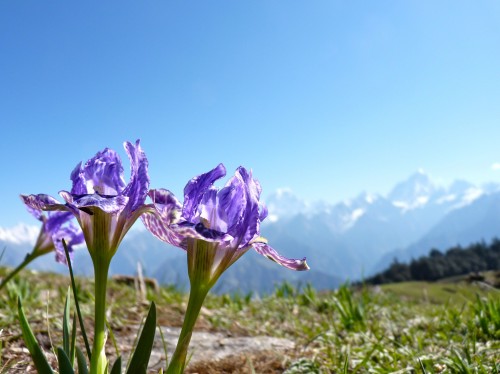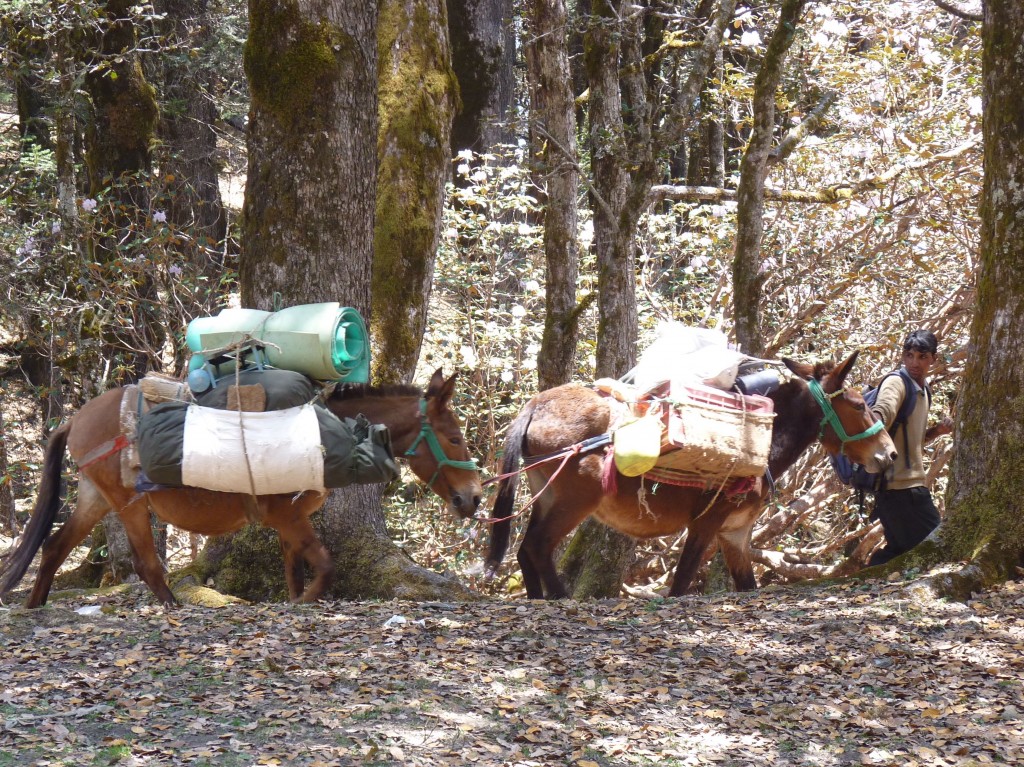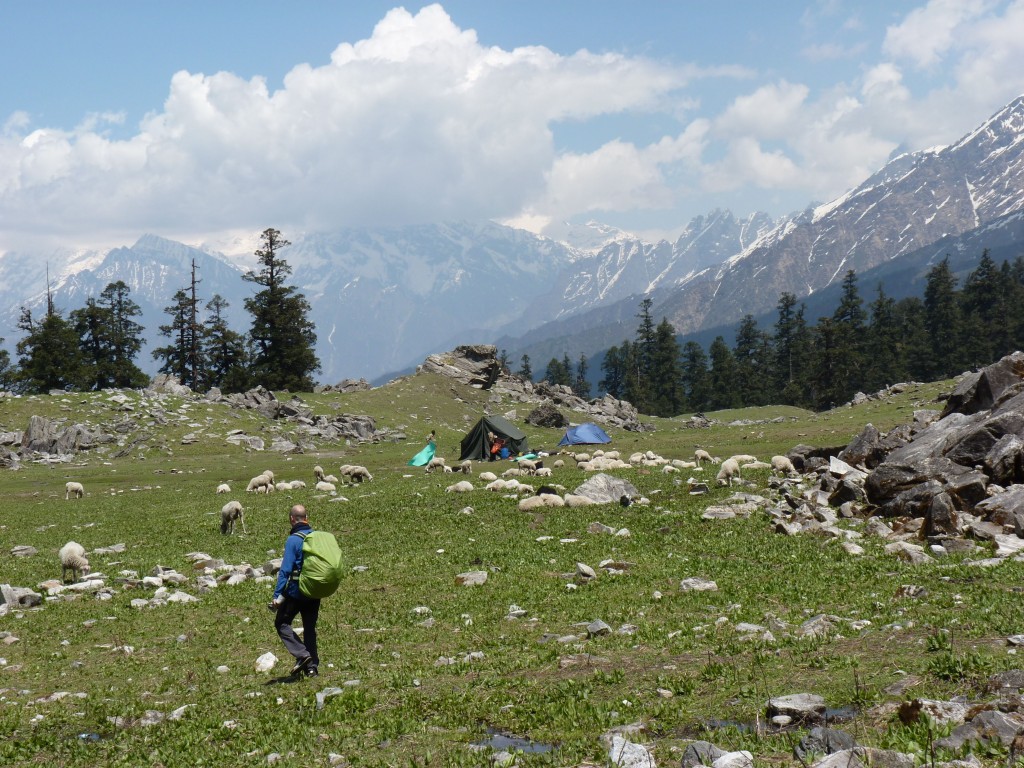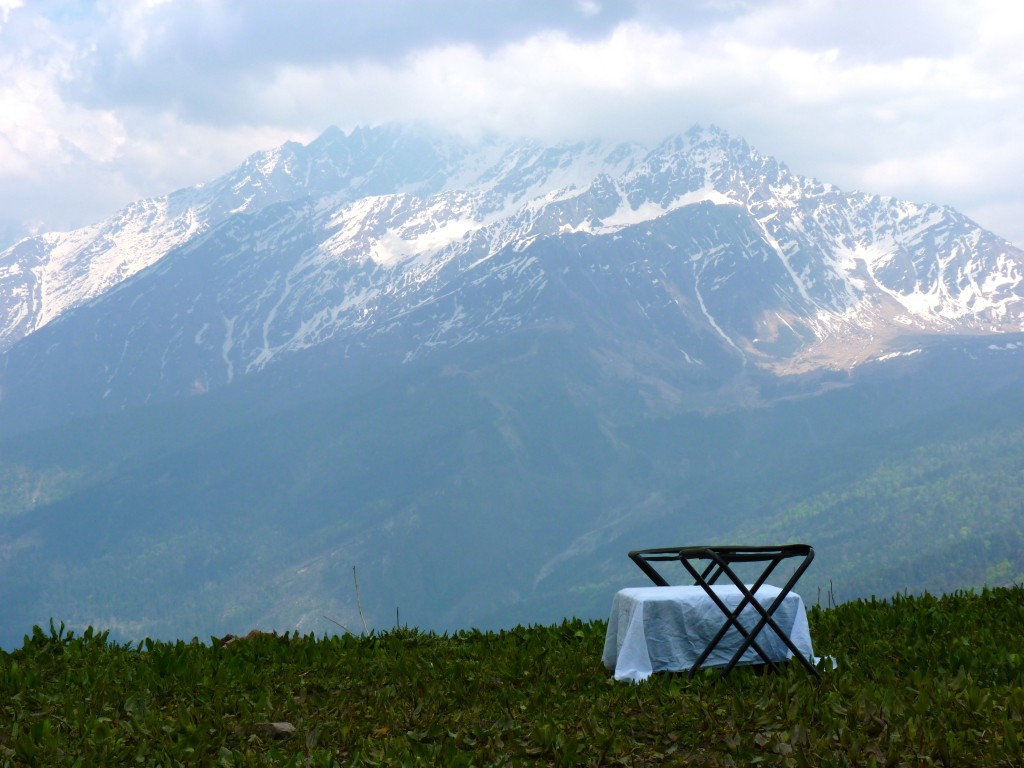For our first steps into the Himalayas and over 3,000 meters, we chose the Kuari Pass. It turned out to be a 5-star experience, a sort of vacation within our India travels, and very easy from a physical standpoint.
Kuari Pass Trek Itineraries
There are two versions of the Kuari Pass trek – a 6-day trek from Ghat village or a 4-day trek starting at Auli, the ski station just above Joshimath. The 6-day trek combines sleeping in villages with camping and goes over the pass at 3,400 meters, finishing in Tapovan or Auli. The 4-day trek is 3 nights of camping and you reach the pass at 3,600 meters, usually coming back down to Dhak village. We did the 4-day version, mainly because we weren’t able to put together a group and the price for just the two of us was too high for us swing the extra two days.
No matter which trek you choose, you’ll have fantastic views, walking through meadows, forest, and mountain trails. The trek itself is very accessible. We hike regularly (though not at any significant altitude) and found it very easy, a little light even. Any trekking company or guide will be able to break the trek down into shorter legs and more days if you have physical limitations. Our guide had recently done the 4-day trek in 8 days with an elderly Danish couple who had no experience trekking or hiking.
Kuari Pass Trek Costs
There are companies in Rishikesh offering packages including transport, lodging, guide, camping, etc or you can arrange everything directly in Joshimath and save a few bucks. Asking around in Joshimath, as of the time of posting, you’re not likely to pay less than 1,500 rupees per person per day in a large group (20+ people) and for smaller groups of under 5 people, it’ll run you 2,000 rupees and up per person per day.
We used Adventure Trekking and were pleased with the service. (Our blog was about one week old when we did the trek, so needless to say we received no compensation or discount from Adventure Trekking – just our own opinion here.) The package included the guide, a cook and a mule handler with two mules. The tent and sleeping bags were also included. We got three huge meals per day, a snack when we reached camp and unlimited chai.
Most of the trekking companies in Joshimath seem to be loosely affiliated, except for a guide named Sonu who works independently. (You can find his mobile number on Indiamike.) Ask around for prices until you get a number you’re comfortable with.
As an aside, the mules are for transporting camping and cooking equipment. They won’t necessarily transport large backpacks on the mules as part of the package. (We happily left everything we didn’t need in a backpack with the trekking company in Joshimath and carried about 4 kilos each between clothes, water, etc.)
Our Trek Experience
The first day we went by jeep from Joshimath to Auli (<1 hour) and then walked for about an hour (3-4 kms) to the first camp site in the woods below Gorson Top. We spent the afternoon watching the cook make our dinner and attempting to chit-chat with the mule handler using our picture dictionary. The views from Gorson Top are spectacular but in terms of hiking, it was sort of a throw-away day and we let the guide know that we wanted to walk more on the following days.
Our second day we walked around 16 kms to Khulara. The trail starts through green meadows dotted with sheep and then along a thin path that hugs the side of a mountain. We had read about a treacherous, razor-thin path, and indeed we ran into a group of inexperienced Indian tourists who were crab-walking down bits of it, but it’s no big deal at all. (Our guide admonished, “Don’t be scared, just stay on your two legs, not like these guys.”) After this exposed stretch, the trail goes through a lovely forest to Khulara. Our guide took us on a slightly extended variant around the back ridge of a mountain, climbing up higher than Khulara and then coming back down.
On the third day, we went up from Khulara to Kuari Pass at 3,600 meters. We wanted to continue to where the Ghat itinerary crosses the Kuari Pass, another 1.5 kilometers or so, but there was still quite a bit of snow and we turned around. With the regular itinerary, the third night is also spent at Khulara and the fourth day is a quick trek down through the forest to Dhak village. We had asked the guide to go back to Auli instead of going down to Dhak village. The trek down to Dhak is through the forest with nothing much to see, and we wanted to repeat the sweeping views of the second day. So on the third night, we camped just before the start of the mountain trail portion of day 2.
On our fourth and last day, we ate an enormous breakfast and took it easy, packing up the camp and setting out at around 9 AM for Auli. It was about a 2-hour walk to Auli where the jeep picked us up to bring us back down to Joshimath.
For us, the trek was a luxury experience and not at all what we were expecting. We are used to hiking on our own, living on oatmeal, pasta, nuts and chocolate. A three-course dinner and a staff to wash the dishes is not really our style but in this case “you get what you pay for” took on a completely positive connotation. It was our first multi-day trek in India and our first trek at any kind of altitude, so we chose to be cautious and go with a trekking company. Which brings us to something you may be thinking…
Do I Really Need a Guide?
It depends on what’s going on with the forestry permits when you visit. Supposedly they do not easily give out permits to individual trekkers without guides, and sometimes they give private guides without the coverage of a registered trekking company a hard time. Objectively, anyone who has hiking experience could probably follow the trail in its current state without a guide. If some day the forestry office decides to put up a few signposts, it would be accessible to even the inexperienced.
In terms of physical stamina, we could have done the trek in two days, the first day from Auli to Khulara and the second day up to Kuari Pass and down to Dhak or back to Auli. That said, the weather was glorious all four days of our trek. If it had been raining, we probably would have been happy to just crawl into the tent after four hours of walking. Also, we didn’t experience any altitude sickness at all, and we’re not sure if that would have been the case if we hadn’t gone up in stages. Lastly, all the trekking companies will cover their bases and make you pay for a minimum 4-day trek even if you want to do it in fewer days. It costs money to mobilize a guide and mules and a cook, and in any case, they can’t risk that you think you can do it in 2 days, then realize you can’t and come down dissatisfied.
Pros
The Kuari Pass trek has an excellent ratio of views for effort.
We also chose the Kuari Pass trek because it could be started from Joshimath. Joshimath is also the launch pad for excursions to Badrinath, Valley of Flowers and Hem Kund, so we figured if the weather was bad or we couldn’t find a guide, there were other things to do nearby.
Cons
If what you’re looking for is serious physical effort, this may not be the trek for you. Our only disappointment was that our asses weren’t kicked.
If you’re looking for solitude or ultra-light backpacking, being forced to travel with a guide, a cook and mules will probably cramp your style.






Post your comment